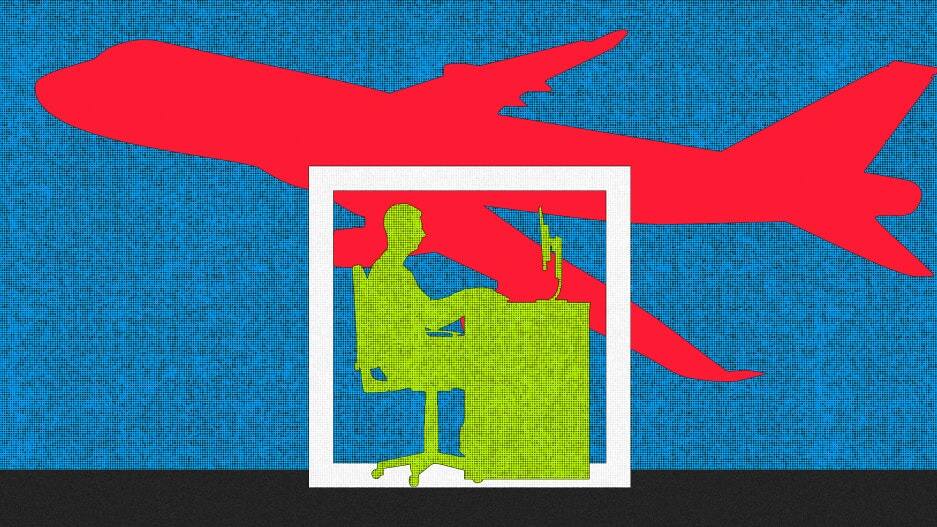- | 8:00 am
4 tangible ways companies are reducing air travel and cutting emissions
The 25 corporations that fly the most are responsible for more than a third of the emissions from business air travel. But some companies are finding ways to change, from encouraging employees to take the train to creating travel carbon budgets.

When someone working at Salesforce needs to make a business trip in the Northeast U.S. or in Europe, the company’s internal travel booking tool will suggest taking the train instead of flying if a viable route is available, flagging it as a more sustainable choice.
It’s one part of the company’s larger plan to reduce corporate emissions. “Our strategy itself looks a lot like the global strategy: travel less, switch to greener options of transportation where you can, and innovate new solutions where you can’t yet,” says Max Scher, VP of sustainability research and innovation at Salesforce.
Like other companies, it started thinking differently about the necessity of travel during the pandemic. But it went farther than most in rethinking its strategy, setting a goal to cut the emissions intensity of its business travel in half by 2030. It even made executive compensation contingent on staying on track for that goal. It’s also working on other approaches to reduce travel emissions, including more virtual meetings and working on ways to ramp up the availability of sustainable aviation fuel. But nudging employees to take the train is a simple step that can quickly help. The rail policy went into place in December 2020; by the first half of last year, rail bookings had grown 100% compared to travel before the pandemic.
PRIORITIZE RAIL WHEN POSSIBLE
“I think it’s really significant to have a U.S. company that’s looking to move air travel to rail,” says Denise Auclair, corporate travel campaign manager for Transport & Environment, a European nonprofit that tracks emissions policies for hundreds of the companies that fly the most and just released a ranking based on how companies are planning to cut those emissions. One of the policies that it recommends companies adopt is to choose rail first.
The U.S. government also recently started asking employees to take the train instead of flying or driving for trips less than 250 miles, when possible. Of course, existing rail infrastructure across the U.S. often doesn’t make that viable. Some companies take different approaches for different regions; PwC, for example, tells employees to take the train for short trips in Austria, but sets a cap on business travel in Canada.
Transport & Environment has found that many companies are slow to change. But a handful, including Salesforce and PwC, are illustrating tangible ways that companies can implement changes.
ADOPT A VIRTUAL-FIRST POLICY
The pandemic proved that in many cases it’s feasible to replace trips with video conferencing. Some companies, like AstraZeneca, have a “virtual first” policy that encourages employees to schedule meetings online whenever it’s possible. The company also tells employees that it’s about more than solely emissions. “It’s good for employees’ work-life balance,” says Auclair. “It’s also good for the company to reduce travel expenses. And it has a positive impact on the environment.”
Tetra Pak, the Swedish manufacturer that makes drink cartons and processing equipment for food factories, set up a global remote support center, so it can often work with customers virtually rather than having to travel. Like some other companies, it’s also starting to become more decentralized: rather than having all engineers headquartered in Sweden, for example, many of them now work near customers in North America.
Of course, there are limits on what can happen remotely. Consulting firms, especially, see the value in face-to-face meetings. But instead of traveling every week to visit a client, they might travel less often. Some firms are talking to clients about travel expectations when projects begin; for clients who are tracking emissions throughout their supply chain, reducing that travel can help improve their overall carbon footprint.
STOP ONE-DAY TRAVEL
Some companies are also trying to eliminate one-day travel—that is, flying out and back for a single meeting. The consulting firm EY, for example, asks employees to try to schedule multiple meetings at their destination, taking trips that are longer but less frequent. The company’s travel emissions are now nearly 60% lower than they were in 2019. (Their target is to cut emissions 35% by next year, so they’re already outperforming that goal.)
CREATE AN EMISSIONS BUDGET FOR FLYING
EY, like other companies, also has a carbon budget for employee travel. Companies that use this approach set an emissions budget for each department for the year, and then figure out how to stay within those limits. Some businesses have also tried internal carbon pricing, or charging an extra internal fee based on emissions to try to disincentivize trips. But that approach doesn’t seem to work well, Auclair says.
The insurance company Swiss Re tried an internal carbon price, “but in the analysis, they said, ‘Look, this isn’t having an effect at all,’” she says. “In fact, emissions were continuing to increase. So they raised the price. But then they also said, this is insufficient in itself—it’s not going to work if it’s the only tool.” The company also set a clear target—keeping travel emissions less than half what they were before the pandemic—and put a carbon budget into place.
Some companies may argue that their air travel emissions are a relatively small part of their own carbon footprint, so they’re not prioritizing action. But Auclair argues that they have an outsized impact on aviation. The 25 corporations that fly most, the nonprofit says, are responsible for more than a third of the emissions from business air travel. If those companies cut air travel in half, it would eliminate the equivalent annual emissions of driving 3 million cars.
Reducing air travel is also “the main thing that needs to be done in this decade that can be done,” Auclair says. “We also work on solutions like sustainable fuels or zero-emissions aircraft, but they’re further down the line. It’s going to be after 2030 that those are going to be more available at scale. So the best thing that can be done now is really to keep those emissions low.”






































